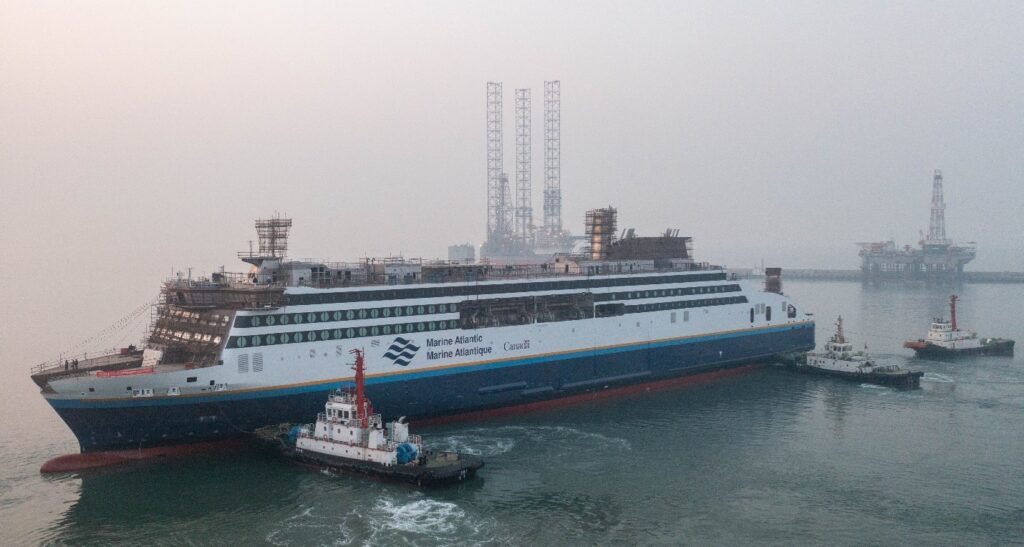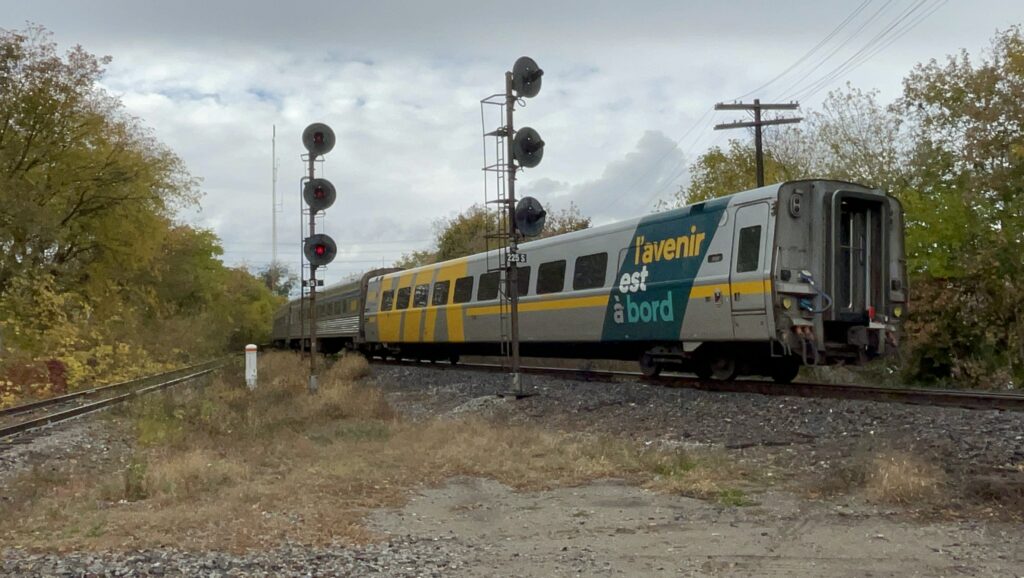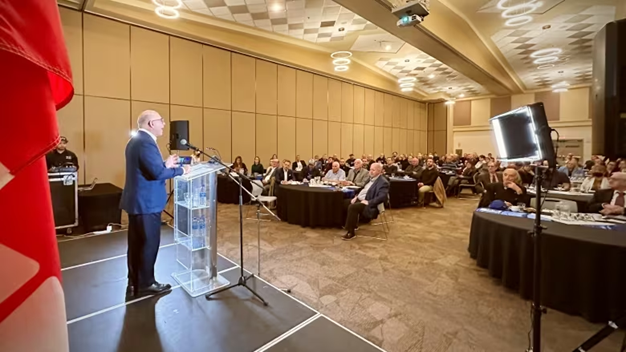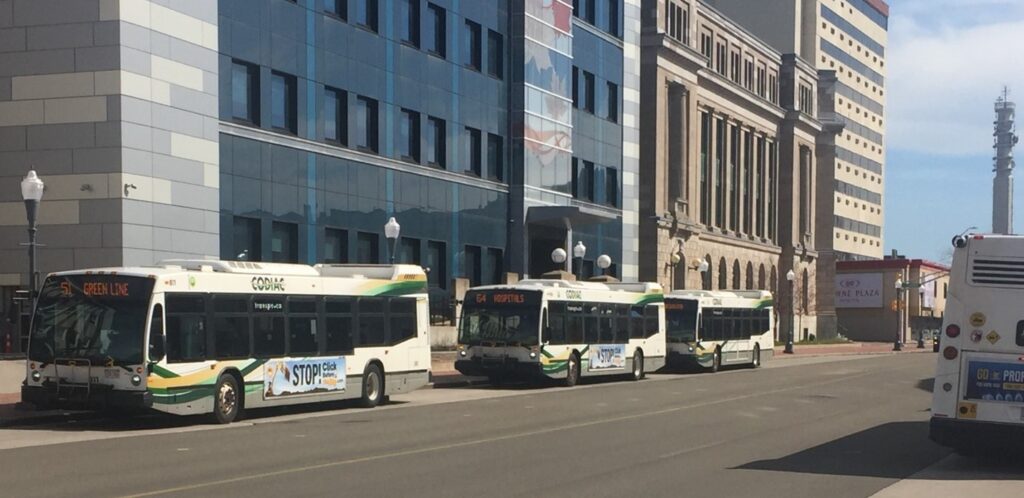Welcome to the April Atlantic Transport News. Here’s a look at what you’ll find in this edition:
- New ferry for Marine Atlantic has been launched
- Northumberland Ferries still seeking replacement ship for PEI
- NB Government hosts transportation symposium
- Details trickle out about VIA HEP fleet testing, feds give little funding support
- No good news for rail in Sydney port announcement
- Union dissatisfied with Halifax Transit driver safeguards
- Codiac Transpo proposes free rides for kids
- Fire shuts down St. John’s airport for two days
- Porter ups the ante on its Eastern promotion
NEW FERRY FOR MARINE ATLANTIC HAS BEEN LAUNCHED

A new addition to Marine Atlantic’s fleet is just a little more than a year away from entering service. The E-Flexer-class ferry is being built for international ferry operator Stena Line at the Chinese state-owned Jinling Shipyard. She was floated out of drydock on March 28, and is now in an adjacent water berth where the bulk of the mechanical, electrical, and interior outfitting will occur over the next several months.
On completion, the new ship – as yet unnamed – will be leased to the federal Crown corporation for a five-year term. Marine Atlantic will have an option to purchase at the end of that period if the vessel proves to be satisfactory to its needs. The company expects the new ferry will arrive in Canada in the spring of 2024, and plans to introduce her on the seasonal Argentia service next June. It hasn’t been officially confirmed, but it would appear that the lease on MV Atlantic Vision – an essential part of the fleet for some 15 years – will be terminated on delivery of the new ship. Although not designed as a “cruise ferry” like the Vision, the new build will offer a similar number of passenger cabins, with the added feature of “sleeping pods” to accommodate single travellers.
“The [new]vessel is designed to meet the changing needs of our customers, and combines key priorities such as improved maneuverability, safety and accessibility while minimizing environmental impacts, to provide a modern, efficient, and reliable ferry service,” said Marine Atlantic spokesperson Darrell Mercer.
A statement from Stena Line said the new ship is 202.9 metres long, 27.8 metres wide, and has a draft of 6.45 metres. It can accommodate 1,100 people and has a lane length of 2,571 metres, including a 476-metre lane for private cars.
Per Westling, managing director of Stena RoRo, said Marine Atlantic is an “old customer” of Stena, which delivered one ferry to the Crown corporation in 2000 and two more in 2010, all of which are still in operation. But the relationship actually dates back to the 1960s, when the first Stena vessel appeared on the North Sydney-Port aux Basques service.
“We focus on making the ship design meet the specific expectations of our customers,” Mr. Westling said. “Our E-Flexer vessels meet customer requirements, combining efficient dual-fuel engines and battery-hybrid solutions to minimize emissions.”
NORTHUMBERLAND STILL SEEKING REPLACEMENT SHIP FOR PEI

The seasonal ferry service between Wood Islands PEI and Caribou NS is set to return on May 1, but a second vessel for the summer peak period was still not confirmed as of this writing. While MV Confederation was undergoing refit at the Newfoundland Dockyard, officials of Northumberland Ferries Limited were working to finalize short-term arrangements for a second vessel to serve the run during the 2023 summer peak.
Company vice-president Mark Wilson was not in a position to reveal the target ship, but he told the Eastern Graphic that he was very confident of a successful outcome in the negotiations. Last year’s temporary replacement was leased from the Quebec provincial ferry corporation STQ, following an engineroom fire that put the 52-year-old MV Holiday Island permanently out of commission. The ancient veteran is currently being scrapped at Sheet Harbour NS, after it was determined that repairs could not be economically justified.
Mr. Wilson acknowledged that this season’s temporary replacement will likely come with strings attached, as did last year’s. He said a more consistent interim vessel will be needed over the next few years, and that’s what NFL is looking for.
“We don’t want to be repeating this process every summer,” he told the newspaper, noting that the 2022 emergency replacement was subject to being recalled at short notice, as it was the designated relief vessel for one of STQ’s regular routes. He added that his company recognizes how important the service is, agreeing with a comment from Blair Aiken, president of the Eastern PEI Chamber of Commerce.
“Every consideration must be given to the continuity of service that’s required for the eastern region of the Island,” Mr. Aiken said. “A temporary replacement, as much as it might be appreciated, isn’t really addressing the issue.”
Other observers – Transport Action Atlantic included – believe the federal government waited far too long to begin planning replacement of the aging Holiday Island, and that the process should have begun years before the shipboard fire that ended her long and faithful career. As it now stands, it will be at least four more years before a new ferry can be designed, tendered and constructed. And by then it will be time to plan for replacing the Confederation, which entered service in 1993.
NB GOVERNMENT HOSTS PUBLIC TRANSPORTATION SYMPOSIUM

There’s some renewed optimism that the Government of New Brunswick may be adopting a more positive view on public transportation, in the wake of a well-attended symposium sponsored recently by the provincial Economic and Social Transit Corporation (ESIC). The two-day event at the Delta Fredericton attracted some 200 attendees from within the province and from other jurisdictions eager to share their advice and success stories. And, significantly, three members of Premier Blaine Higgs’ cabinet made an appearance with all three expressing their support for better transportation options in New Brunswick.
It just may mark a turning point in the governing PC Party’s attitude toward transportation in general and public transit in particular. The Higgs government has left millions in federal transit funding on the table in recent years, after declining to match the offer with matching provincial dollars. The premier once famously and flippantly remarked that “Fredericton doesn’t need a subway” – while ignoring the reality that the capital city certainly could benefit from more efficient bus transit with service seven days a week.
The minister responsible for ESIC, Dorothy Shephard, was brimming with enthusiasm in a statement released after the symposium concluded.
“The issue of transportation is important to everyone in our province,” she said, “allowing our residents to move for reasons such as employment, health, training and leisure. It was a pleasure to discuss various opportunities for our province with such a dedicated group of passionate and experienced participants and guest speakers.”
It would seem Minister Shephard supports the philosophy expressed by a number of symposium participants: that public transportation is for everybody – not just the socially disadvantaged. The event provided an opportunity to learn more about the current context in New Brunswick, leading models in the Maritimes and Canada, regulations and policy considerations, available funding, and networking. Municipal public transit as well as accessible and active transportation were also addressed.

The stated objective of the symposium was to lay the foundation for integrated regional transport strategies in connection with the reform of local governance and the provincial plan to overcome poverty. A key component is the development and implementation of regional plans to increase the accessibility, affordability and availability of transportation services.
“The Economic and Social Inclusion Corporation is pleased to have brought together stakeholders, funders and transportation providers during the symposium,” said Jean Allain, chair of the corporation’s board. “We need the collaboration of all stakeholders to ensure that residents of the province will benefit from partnership arrangements for transportation. I believe we are on track.”
DETAILS TRICKLE OUT ABOUT VIA HEP TESTING, WHILE FEDS GIVE LITTLE FUNDING SUPPORT

The testing of VIA Rail’s stainless steel “HEP” equipment has been underway since the beginning of the year, with several cars sent to CAD rail services in Montreal for tear-down inspections, and a smaller group sent to the National Research Council’s facility in Ottawa for destructive compression testing. The testing will confirm whether the cars are safe for continued operation, and what interventions may be needed to keep them operating for the remainder of their service lives. In the interim, all trains operating with HEP equipment have required unoccupied “buffer” cars at the front and rear of consists.
Formal details haven’t yet been released, but rail enthusiast and blogger Eric Gagnon received the most detailed breakdown of results to date via an Access to Information request, which he published on his Trackside Treasure blog. Overall, the results so far have been positive, and while some defects have been identified there does not appear to be anything of critical concern that would require the fleet to be withdrawn immediately. Based on both these reports and other unofficial sources, it sounds like the buffer car requirement may also be removed in the near future, a move that would help free up more equipment to be put back into revenue service.
Whether this testing goes well or not, it’s still clear that the extended service life of this equipment is limited and fleet replacement plans will need to continue moving ahead. VIA has begun this process and issued a request for information to interested suppliers earlier this year, but a formal procurement can’t get underway without government funding commitments. The 2023 federal budget didn’t offer anything for fleet replacement, though the budget does allocate $210 million over five years to “conduct maintenance on its trains on routes outside the Québec City–Windsor Corridor and to maintain levels of service across its network.” It’s not yet clear what this funding will actually cover, how much will be focused on the required repairs from the testing outcomes, or how much might be allocated to further refurbishment work. Regardless, the end of the line is still within sight, and fleet replacement plans need to continue to stay on the radar is there is to be any long-term future or true modernization of VIA’s long distance services.
NO GOOD NEWS FOR RAIL IN SYDNEY PORT ANNOUNCEMENT

There was a significant announcement on March 23 concerning the proposed Novaporte development on Sydney harbour – but it didn’t do anything to assure a more secure future for Cape Breton’s dormant and derelict rail line.
Construction is expected to start this year on land that had been set aside in the Sydney harbour for a proposed container terminal, but it won’t be what the developer initially sought. Instead, Novaporte plans to build a facility on Cape Breton Regional Municipality land that will import parts for large offshore wind turbines.
Company CEO Albert Barbusci said that he’s still working on the container terminal project, but an opportunity came up in what many expect will be a burgeoning offshore wind industry, and it would fit in with a container terminal.
“Really what we’ve done is we’ve doubled down. We’ve doubled the opportunity,” Mr. Barbusci told CBC News. The wind turbine facility will be operated by Blue Water Shipping of Denmark, a company with 25 years experience in European offshore wind logistics.
Both the municipality and the Membertou First Nation, which purchased a one-eighth stake in Novaporte several years ago, were delighted at the announcement.
“This is the first time since I’ve been on council that we’ve seen such a significant move forward and the asset is actually going to be used now to create that value, to create that economic driver for our community,” said Mayor Amanda McDougall. “It’s not a container terminal, but it’s a start. Passing up an opportunity to get into the offshore wind industry to me would be such a shame. and we would be in the same place as Cape Breton was decades ago when we lost coal and steel.”
Mr. Barbusci said he expects construction to begin later this year, with the turbine marshalling area ready to begin operating in 2026. The container terminal proposal is ready to go, he said, but it needs a working railway. The wind turbine marshalling project does not need rail. Ships would deliver the large parts for storage, and companies building offshore wind farms would pick up the components and assemble them at sea. But he clearly hasn’t given up on the container terminal plan.
“We want jobs. We want revitalization, but we can’t ignore this green opportunity. It’s too good. It’s too big, and it really will get done.”
UNION DISSATISFIED AT HALIFAX TRANSIT DRIVER SAFEGUARDS

The Halifax Regional Municipality has invited quotes to supply a driver protection system aboard Halifax Transit’s buses, but the Amalgamated Transit Union says the plan doesn’t go far enough. Local 508 president Shane O’Leary told CBC News that the protection systems are a starting point for ensuring driver safety, but more needs to be done.
The municipality’s request for quotation issued on April 1 invites pricing on up to 370 units of “slide and stow” protection systems that have “a sliding partition that only the operator can adjust,” and “prevent sudden intrusion into the bus operator’s area,” among other requirements.
“The shields will help if they’re installed properly and done right and it’s a good quality shield. But that’s not enough,” Mr. O’Leary said in an interview, adding that attacks on transit drivers have been on the rise in recent years, and many have involved groups of youths. Creating a transit police force with the power to issue fines and remove passengers from buses would be a further step toward protecting transit operators, he said.
HRM spokesperson Maggie-Jane Spray said in an e-mailed statement to CBC that recently approved funding from the regional council in the upcoming budget year will mean that “all electric buses will be equipped with operator safety barriers when they arrive, beginning in late 2023.”
When asked if the city has kept a record of incidents of violence against drivers, she said the number of incidents “is difficult to quantify, as not all incidents of aggression or violence would meet the threshold for an incident report, as opposed to a situation involving an assault for which a Halifax Transit supervisor and/or police would be called.
CODIAC TRANSPO PROPOSES FREE RIDES FOR KIDS

Kids under 13 in the Greater Moncton area will likely be riding transit for free by the end of the summer. Codiac Transpo is proposing to eliminate fares for children when accompanied by an adult. Riverview and Dieppe councils have already approved the concept, and a presentation is planned at Moncton City Hall in the near future.
Angela Allain, head of Codiac Transpo told Riverview Council that offering free service to that cohort will get them accustomed to transit use, and help build ridership over the long term. She anticipates that increased transit usage will eventually offset the initial loss of farebox revenue.
It’s not exactly a unique idea, but rather part of a nationwide trend. Ms. Allain said 27 other transit systems in Canada already offer a similar youth fare concession. (Some systems are even more generous.) These include the TTC and Go Transit in Ontario, as well as Halifax Transit, St. John’s Metrobus, Island Transit and Charlottetown’s T3 here in the Atlantic region.
Currently children under six ride free on Codiac Transpo. The same applies on the Fredericton and Saint John systems. There’s no indication yet that the other two New Brunswick cities are proposing a similar initiative.
FIRE SHUTS DOWN ST. JOHN’S AIRPORT FOR TWO DAYS

A late-night fire on Friday, March 24, caused significant smoke and water damage to the passenger terminal at St. John’s Airport – sufficient to put the facility out of business for almost two full days.
The outbreak is believed to have started around 11:30 pm in the ceiling above a children’s play area adjacent to gate 11. Staff were first alerted to the fire by smoke detector alarms and the facility was quickly evacuated as emergency responders located the blaze, airport CEO Dennis Hogan told the Telegram. The building was nearly empty at that late hour, and there were no injuries reported.
“There were some flames visible at one point in time and both our emergency fire responders here at the airport and St. John’s Regional (Fire Department) worked very diligently and quickly to suppress the fire and really contain it from going any further,” he said. Initially management had hoped to resume operations on Saturday, but it turned out that damage was more severe than initially thought, and flight operations did not resume until Sunday evening. Some 36 flights were impacted by the fire, but an undetermined number of others had already been cancelled due to a late winter storm.

PAL Airlines was able to take advantage of being based in St. John’s by moving operations to its maintenance hangar, so the impact on its flights was minimal. All other airlines using YYT were completely out of business for the duration of the terminal closure. First flights resumed on Sunday evening, March 26.
Airport officials said the fire does not appear to have been of suspicious origin, but no cause has been released.
PORTER UPS THE ANTE ON ITS EASTERN PROMOTION

There’s further evidence this month that Porter Airlines is aggressively trying to build market share in Atlantic Canada. The upstart airline’s raccoon mascot – known as “Mr. Porter” – is reaching out to prospective and existing customers through social media posts and e-mail blasts to promote their frequent flyer plan and unique economy-class perks. Clearly taking aim at WestJet, the ad material asks travellers if they are “feeling abandoned”, and assures them that Porter will match their status with the other carrier.
As we’ve reported earlier in this space, WestJet has drastically curtailed its services to Atlantic Canada in recent months, while Porter is increasing both frequency and the number of destinations served in the region.




